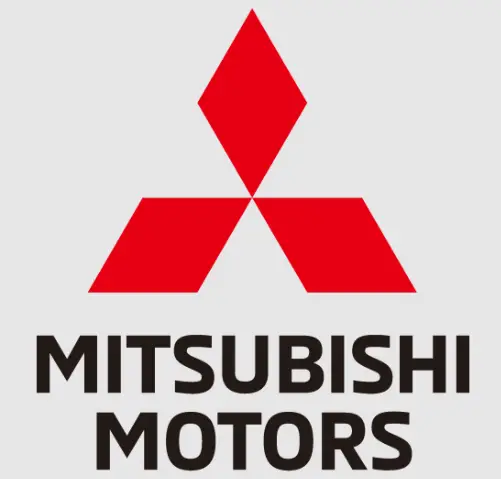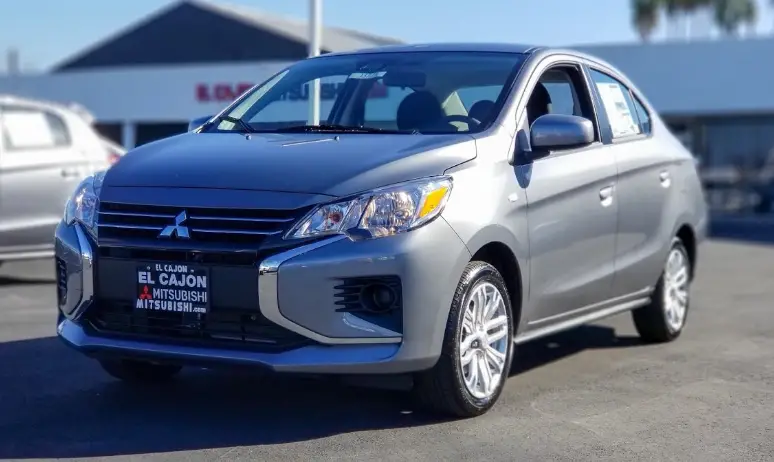
2021 Mitsubishi Mirage G4 Owner’s Manual
The 2021 Mitsubishi Mirage G4 was released as a subcompact sedan, giving customers who are trying to save money a cheap and fuel-efficient choice. The Mirage G4 was made to work well in cities because it is small and easy to drive. This makes it a great choice for city workers and commuters. It had an efficient 1.2-liter, three-cylinder engine that got good gas mileage, and the inside was simple and functional, with current technology and safety features. Even though the Mirage G4 had a small footprint, it was designed to have a surprising amount of space inside and a useful trunk, which added to its draw as a practical and inexpensive subcompact sedan.
General information
Fuel selection
Your vehicle is designed to use unleaded gasoline only. It is equipped with a fuel tank filler pipe specifically designed to accept only a small-diameter unleaded gasoline dispensing nozzle.
WARNING: Gasoline is highly flammable and explosive. You could be burned, seriously injured, or killed when handling it. Whenever you refuel your vehicle, stop the engine and keep flames, sparks, and smoking materials away from the vehicle. Always handle fuel in well-ventilated outdoor areas.
CAUTION: Using leaded gasoline in your vehicle will damage the engine, catalytic converter, and oxygen sensors. Also, using leaded gasoline is illegal, and will void your warranty coverage of the engine, catalytic converter, and oxygen sensors.
Gasoline detergent additives
In the United States, fuel suppliers are required by law to add detergents to their gasoline to minimize fuel-injector clogging and minimize intake-valve deposits. Detergent gasoline helps keep your engine in tune and your emission-control system working properly.
Octane requirement
Your vehicle is designed to operate on unleaded gasoline having a minimum octane number of 87 [(MON+RON)/2] or 91 RON.
Oxygenated gasoline
Gasoline sold at some service stations contains oxygenates such as ethanol, although the oxygenates may not be identified by those names. Oxygenates are required in some areas of the country. Such fuel can be used in your vehicle.
Ethanol (Gasohol)
A mixture of up to 10 % ethanol (grain alcohol) and 90 % unleaded gasoline may be used in your vehicle, provided the octane number is at least as high as that recommended for unleaded gasoline.
Methanol
Do not operate your vehicle on gasoline containing methanol (wood alcohol). Using this type of alcohol could adversely affect the vehicle’s performance and damage critical parts of the vehicle’s fuel system.
Reformulated gasoline
Many areas of the country require the use of cleaner burning fuel referred to as “Reformulated Gasoline”.
Reformulated gasoline contains oxygenates and is specially blended to reduce vehicle emissions and improve air quality. Mitsubishi Motors Corporation strongly supports the use of reformulated gasoline. Properly blended reformulated gasoline has no adverse effect on vehicle performance or the durability of the engine and fuel system.
MMT (methylcyclopentadienyl manganese tricarbonyl)
MMT is a manganese-containing metallic additive that is blended into some gasoline to increase the octane number. Mitsubishi Motors Corporation recommends using gas lines without MMT. The use of gasoline blended with MMT may adversely affect performance and cause the malfunction indicator on your instrument panel to come on. If this happens, contact an authorized Mitsubishi Motors dealer or a repair facility of your choice for assistance.
Sulfur in gasoline
Your vehicle may have been designed to satisfy California’s low-emission regulations based on clean-burning low-sulfur gasoline. Gasoline sold in parts of the country other than California is allowed to have a higher sulfur content. Using such gasoline could adversely affect the vehicle’s catalytic converter and cause the engine malfunction indi-cator (“SERVICE ENGINE SOON”) to come on. Illumination of this indicator while using high-sulfur gasoline does not necessarily mean the vehicle’s emission control system is malfunctioning. Your authorized Mitsubishi Motors dealer may suggest using a different, lower-sulfur brand of unleaded gasoline to determine if the problem is fuel-related.
NOTE
- Poor-quality gasoline can cause problems such as hard starting, stalling during idling, abnormal engine noise, and poor acceleration. If you experience any of these problems, try using a different brand of gasoline. If the engine malfunction indicator (“SER-VICE ENGINE SOON”) flashes, have the vehicle inspected as soon as possible by the nearest authorized Mitsubishi Motors dealer or a repair facility of your choice.
- Repeatedly driving short distances at low speeds can cause deposits to form in the fuel system and engine, resulting in hard starting and poor acceleration. If these problems occur, you are advised to add a detergent additive to the gasoline when you refuel the vehicle. The additive will remove the deposits, thereby returning the engine to a normal condition. Be sure to use a Mitsubishi Motors Genuine cleaning additive. Using an unsuitable additive could make an engine malfunction. For details, please contact the nearest authorized Mitsubishi Motors dealer.
Filling the fuel tank
WARNING
- When handling fuel, comply with the safety regulations displayed by garages and filling stations.
- Gasoline is highly flammable and explosive. You could be burned, seriously injured, or killed when handling it. When refueling your vehicle, always turn the engine off and keep away from flames, sparks, and smoking materials. Always handle fuel in well-ventilated outdoor areas.
- Before removing the fuel tank filler cap, be sure to get rid of your body’s static electricity by touching a metal part of the car or fuel pump. Any static electricity on your body could create a spark that ignites fuel vapor.
- Perform the whole refueling process (opening the fuel tank filler door, removing the fuel tank filler cap, etc.) by yourself; do not let any other person near the fuel tank filler. If you allowed a person to help you and that person was carrying static electricity, fuel vapor could be ignited.
- Do not move away from the fuel tank filler until refueling is finished. If you moved away and did something else (for example, sitting on a seat) part-way through the refueling process, you could pick up a fresh charge of static electricity.
- Be careful not to inhale fuel vapor. Fuel contains toxic substances.
- Keep the doors and windows closed while refueling the vehicle. If they were open, fuel vapor could get into the cabin.
Fuel tank capacity
Refueling
- Before filling with fuel, stop the engine.
- The fuel tank filler is located on the rear driver’s side of your vehicle. The fuel tank filler door can be opened from inside the vehicle with the fuel tank filler door release lever located at the left side of the driver’s seat.
- Open the fuel tank filler pipe by slowly turning the fuel tank filler cap counterclockwise.

- While filling with fuel, hang the fuel tank filler cap cord on the hook located on the inside surface of the fuel tank filler door.
WARNING: Since the fuel system may be under pressure, remove the fuel tank filler cap slowly. This relieves any pressure or vacuum that might have built up in the fuel tank. If the fuel tank filler cap is venting vapor or if you hear a hissing sound, wait until the sound stops before removing the fuel tank filler cap. Otherwise, fuel may spray out, injuring you or others. - To fill with fuel correctly depends mainly on the correct handling of the fuel filler nozzle. Do not tilt the nozzle. Insert the nozzle in the fuel tank filler port as far as it goes.
CAUTION: Your vehicle can only be operated using unleaded gasoline. Serious engine and catalytic converter damage will result if leaded gasoline is filled into these vehicles, and consequently, this must never be attempted. - When the nozzle stops automatically, do not add more fuel.
CAUTION: To avoid fuel spillage and overfilling, do not “top off” the fuel tank. Spilled fuel could discolor, stain, or crack the vehicle’s paintwork. If fuel spills on the paintwork, wipe it off with a soft cloth. - To close, turn the fuel tank filler cap slowly clockwise until you hear clicking sounds, then gently push the fuel tank filler door closed.
WARNING: Make sure the fuel tank filler cap is securely closed. If the fuel tank filler cap were loose, fuel could leak, resulting in a fire.
CAUTION: If you need to replace the fuel tank filler cap, use only the fuel tank filler cap specified for your model vehicle.
NOTE
- If the fuel tank filler cap is not tight while driving, the engine malfunction indicator (“SERVICE ENGINE SOON”) may come on when the onboard diagnostic (OBD) system performs a self-check.
- Always tighten the fuel tank filler cap until you hear at least 3 clicks.
- The indicator will go off after several driving cycles. If the indicator does not go off, contact your authorized Mitsubishi Motors dealer or a repair facility of your choice as soon as possible.
Modifications to and racing of your vehicle
This vehicle should not be modified with non-Mitsubishi Motors genuine parts. Mitsubishi Motors designs and manufactures high-quality vehicles with an emphasis on safety and durability. Modifications using non-Mitsubishi Motors genuine parts may affect the performance, safety, and/or durability of your vehicle, and may violate applicable state and/or federal regulations. DAMAGE OR PERFORMANCE PROBLEMS RESULTING FROM MODIFICATIONS TO OR RACING OF YOUR VEHICLE ARE NOT COVERED UNDER WARRANTY.
Examples of modifications to your vehicle that can cause damage or performance problems include the following:
- Failure to use Mitsubishi Motors genuine parts
- Failure to use required fuel and fluids
- Failure to use proper-size tires and wheels
- Modification of the fuel, intake, exhaust, emission, suspension, engine, drive train, or electrical wiring systems
- Modification of any onboard computer/control module, including reprogramming, or replacing/adding chips to any onboard computer/control module
Review the Warranty and Maintenance Manual for further details regarding warranty coverage.
FAQ’s
A: The 2021 Mitsubishi Mirage G4 comes in two trim levels: ES and LE.
A: The Mirage G4 is equipped with a 1.2-liter three-cylinder engine producing 78 horsepower and 74 lb-ft of torque.
A: The 2021 Mirage G4 offers both a 5-speed manual transmission and a continuously variable transmission (CVT).
A: The Mirage G4 with the CVT is rated at approximately 35 mpg in the city and 41 mpg on the highway, making it highly fuel-efficient.
A: Standard safety features include a rearview camera, stability control, traction control, and a tire pressure monitoring system.
A: The Mirage G4 offers a comfortable interior with seating for five and 89.5 cubic feet of passenger volume.
A: Yes, the Mirage G4 comes with a 7-inch touchscreen infotainment system in the LE trim, which includes Apple CarPlay and Android Auto compatibility.
A: The Mirage G4 provides a generous 12.6 cubic feet of trunk space, which is impressive for a subcompact sedan.
A: With its compact size and nimble handling, the Mirage G4 is well-suited for navigating urban environments and tight parking spaces.
A: Mitsubishi offers a 5-year/60,000-mile basic warranty and a 10-year/100,000-mile powertrain warranty for added peace of mind.
A: While it lacks advanced driver-assistance features like adaptive cruise control, it does come with standard safety features such as brake assist and hill-start assist.
A: Yes, the LE trim offers a Popular Equipment Package, which includes features like alloy wheels, a leather-wrapped steering wheel, and more.
A: The Mirage G4 is competitively priced, making it one of the more affordable options in the subcompact sedan segment.
A: Yes, the Mirage G4 features a 60/40 split-folding rear seat, allowing you to expand the cargo area when needed.
A: Color options may vary by trim level, but typical choices include Pearl White, Sapphire Blue, Mystic Black, Starlight Silver, and more, depending on availability.
Useful Link
2022 Mitsubishi Mirage G4 Owner’s Manual
2021 Mitsubishi Mirage User Manual

